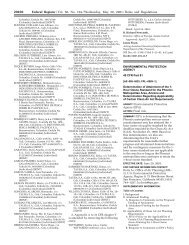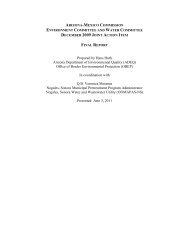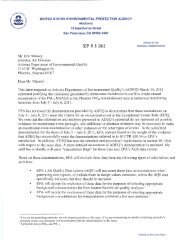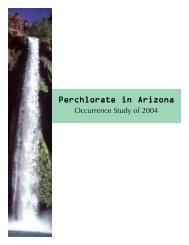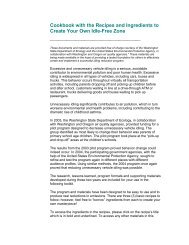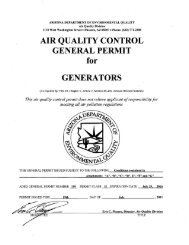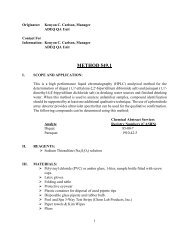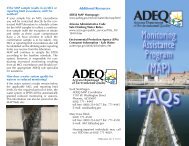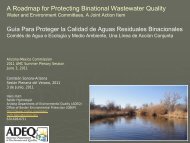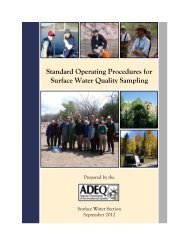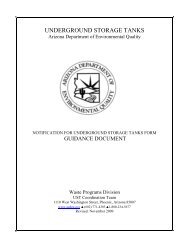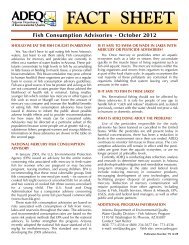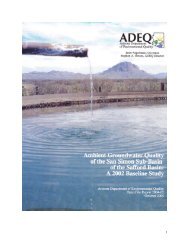Detrital Valley Basin - Arizona Department of Environmental Quality
Detrital Valley Basin - Arizona Department of Environmental Quality
Detrital Valley Basin - Arizona Department of Environmental Quality
You also want an ePaper? Increase the reach of your titles
YUMPU automatically turns print PDFs into web optimized ePapers that Google loves.
Figure 2. Windmills, such as “Twin Mills”in the<br />
Black Mountains are used by ranchers for<br />
stock water. Groundwater is found at<br />
shallow levels near the mountains and<br />
historically these have been important<br />
sources <strong>of</strong> water in the <strong>Detrital</strong> <strong>Valley</strong> basin.<br />
Limited amounts <strong>of</strong> groundwater are<br />
also found in mountain hardrock areas<br />
where the bedrock is sufficiently faulted<br />
and fractured and/or where thin deposits<br />
<strong>of</strong> alluvium occur. Although usually<br />
yielding less than 50 gpm in springs and<br />
shallow wells (Figure 2), historically<br />
this has been an important water source<br />
because <strong>of</strong> its greater accessibility. 2<br />
Groundwater is also found in the Lake<br />
Mead aquifer located in northern areas<br />
adjacent to the reservoir created with<br />
the completion <strong>of</strong> Hoover Dam in 1935<br />
which impounded the Colorado River.<br />
This aquifer consists largely <strong>of</strong><br />
recharged water from Lake Mead,<br />
which has saturated the previously dry<br />
alluvium and sedimentary rocks above<br />
the level <strong>of</strong> the Colorado River.<br />
Groundwater movement in the DET is<br />
from the surrounding mountains toward<br />
the <strong>Detrital</strong> Wash and north toward<br />
Lake Mead. 2 A potential groundwater<br />
drainage divide has been reported in the<br />
northern part <strong>of</strong> the basin, which may be<br />
related to the effects <strong>of</strong> a salt body in<br />
the area which tends to impede<br />
groundwater flow to the north. 3<br />
“Groundwater in the alluvial<br />
aquifer appears to be very old,<br />
judging from isotopes and a sodium<br />
-mixed chemistry that contains<br />
trace elements such as arsenic and<br />
chromium.”<br />
Essentially all streamflow in the DET is<br />
ephemeral, generated by precipitation in<br />
the surrounding mountains. Surface<br />
flow rarely reaches the central parts <strong>of</strong><br />
the valley because <strong>of</strong> evapotranspiration<br />
and infiltration on alluvial fans, areas<br />
which provide most <strong>of</strong> the groundwater<br />
recharge. 3 The majority <strong>of</strong> the basin is<br />
drained by <strong>Detrital</strong> Wash, an ephemeral<br />
watercourse that debouches into Lake<br />
Mead at Bonelli Bay west <strong>of</strong> the resort<br />
community <strong>of</strong> Temple Bar (Figure 3).<br />
IV. Methods <strong>of</strong> Investigation<br />
This study was conducted by the ADEQ<br />
Ambient Groundwater Monitoring<br />
Program, as authorized by the<br />
legislative mandate in <strong>Arizona</strong> Revised<br />
Statutes §49-225. To characterize<br />
regional groundwater quality, 28 sites<br />
(21 wells and 7 springs) were sampled.<br />
Most sample sites were located in the<br />
southern part <strong>of</strong> the basin as few sites<br />
were available for sampling in the<br />
northern portion <strong>of</strong> the DET.<br />
Samples were collected at all sites for<br />
inorganic constituents and isotopes <strong>of</strong><br />
hydrogen and oxygen. At selected sites,<br />
samples were also collected for<br />
radiochemistry (11 sites) and radon gas<br />
(11 sites) analyses. In addition, isotope<br />
samples were collected from Lake<br />
Mead and <strong>Detrital</strong> Wash.<br />
Sampling protocol followed the ADEQ<br />
<strong>Quality</strong> Assurance Project Plan. Based<br />
on quality control data, the effects <strong>of</strong><br />
sampling equipment and procedures<br />
were not considered significant.<br />
Figure 3. The basin is largely drained by<br />
<strong>Detrital</strong> Wash, a wide, shallow, typically dry<br />
watercourse. Those unfamiliar with the<br />
intensity <strong>of</strong> desert thunderstorms find it<br />
difficult to believe that this dusty wash can<br />
quickly become a full-blown river.<br />
Map 3. The 28 <strong>Detrital</strong> <strong>Valley</strong> basin sample sites<br />
are color-coded according to water quality<br />
standard status. Health-based water quality<br />
exceedances are in red and orange, aestheticsbased<br />
water quality guidelines are in red and<br />
yellow, and blue sites have no exceedances.<br />
V. Water <strong>Quality</strong> Sampling Results<br />
The collected groundwater quality data<br />
were compared with <strong>Environmental</strong><br />
Protection Agency (EPA) Safe Drinking<br />
Water (SDW) water quality standards.<br />
Primary Maximum Contaminant Levels<br />
(MCLs) are enforceable, health-based<br />
water quality standards that public<br />
systems must meet when supplying<br />
water to their customers. Primary<br />
MCLs are not acute standards but based<br />
on a lifetime daily consumption <strong>of</strong> two<br />
liters <strong>of</strong> water. Of the 28 sites sampled,<br />
9 had constituent concentrations<br />
exceeding a Primary MCL (Map 3). At<br />
three sites each, arsenic (under<br />
standards effective in 2006), gross<br />
alpha, and nitrate concentrations each<br />
exceeded Primary MCLs.<br />
EPA SDW Secondary MCLs are<br />
unenforceable, aesthetics-based water<br />
quality guidelines for public water<br />
systems. Water with Secondary MCL<br />
exceedances may be unpleasant to drink<br />
and/or create unwanted cosmetic or<br />
laundry effects but is not considered a<br />
health concern. Of the 28 sites sampled,<br />
11 had constituent concentrations<br />
exceeding a Secondary MCL (Map 3).<br />
Constituents above Secondary MCLs



